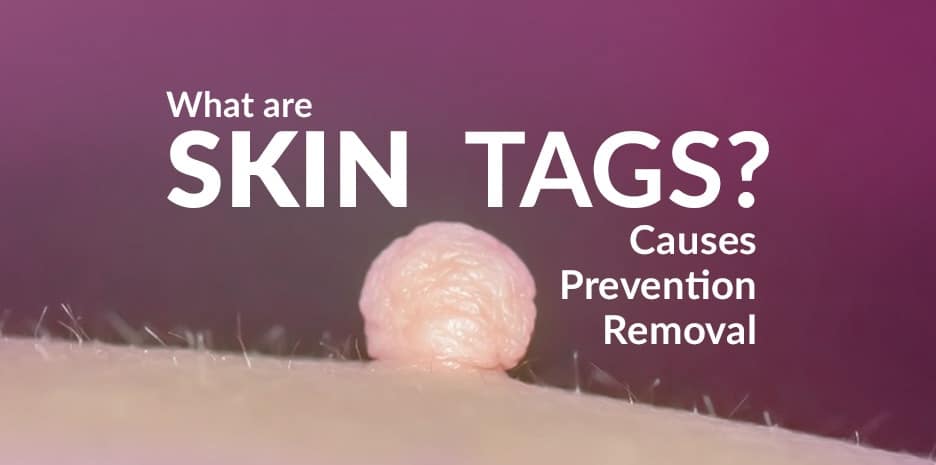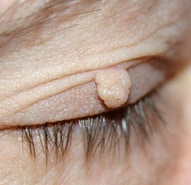
OC 949-428-4500
LA 310-460-2444

They look like small flats of hanging skin and are more common than you imagine.
Although not dangerous or painful, skin tags, scientifically known as acrochordon or fibroepithelial polyps, are a source of discomfort. That is why so many people are eager to get rid of them as soon as they develop. Before learning how to remove skin tags safely and painlessly, here are just a few of the questions about skin tags and what they are all about that we are going to answer in this post:
Skin tags are small, benign tumors that look like brownish bumps hanging from fleshy stalks (peduncles). Known under the medical term “acrochordons”, they are also called “skin tabs.”
Ranging from what one may consider tiny (2 mm) to huge (5 cm), skin tags affect nearly everyone at least once in a lifetime. Both males and females are prone to developing such lesions. Although they may be found on toddlers, more often then not, they are found on adults.These undesirable skin lesions mostly occur in obese people and pregnant women. The good news is that skin tags during pregnancy are not considered dangerous, and require treatment to remove them only if bothersome. Plus, they can be easily removed by a dermatologist.
Wart-like bumps occur on dogs too, and they are often confused with canine skin cancer. What you should know, though, is that skin tags on dogs are pretty harmless. As compared to warts, they should display the same color as your dog’s skin, be thinner at the base, and dangle.
Skin Tag on Eyelid
At the same time, skin tags may occur in less noticeable spots such as the tongue, on the shaft of the penis (penile skin tags), inside the vagina or anus (also known as hemorrhoids or otherwise called hemorrhoidal skin tags), or even on the nipples. There are multiple areas where skin tags can grow.
However, brownish growths that form in genital, perianal, and anal areas may actually be genital warts. Vaginal skin tags or skin tag-like bumps that develop on the scrotum are uncommon as these lesions tend to occur in dry areas. There are vaginal skin tags that may develop at the external genitalia/ vulva (labia majora and labia minora), and if they get irritated, they can become itchy and sore.It is important to note that skin tag like growths on the genitals could be genital warts. It is very important that you get these types of growths checked out by your doctor as soon as possible.
There are ways to distinguish between the two. Skin tags appear like a stalk and usually occur in a dry area of the skin. They do not appear in or around the vagina. They appear singly or in pairs and are not itchy or painful.
Genital warts on the other hand typically grown in groups or clusters in or around the vagina or anal area. They are flat, round and cause itching pain or bleeding.The most common cause of a skin tag is friction. They appear where the skin rubs against skin or where the skin rubs against clothing such as on the neck, tummy, and back. Typically under folds of skin.
As they typically occur in skin creases, bunches of collagen and blood vessels that are trapped in the subcutaneous tissue are also said to cause the growths.
Among other causes, age, heredity, and obesity are known to increase the likelihood of developing such tumors. That means there is a good chance you get them if:

Skin tags are not cutaneous malignant conditions, which means they have no cancer potential. However, if they become abnormally large, bleed, or display colors such as red, brown, or black, you should see a doctor. There are rare instances when a skin tag may transform into a cancerous lesion.
Wondering if these annoying bumps are contagious? Rest assured, they are not. This is actually one of the aspects that sets a skin tag apart from a wart. While warts can be cancerous and are known to be very contagious as they are caused by a virus called HPV (human papillomavirus), skin tags are not transmissible.
However, if your skin tags display unusual characteristics, and you experience abnormal symptoms, you should contact your doctor to exclude the possibility of a more severe skin condition. For instance, moles, warts, and skin cancers are known to mimic skin tags.
Here are a few images showing the difference between a skin tag and a mole, wart, milia, and Seborrheic Keratosis.
Dermatologists recommend getting rid of skin tags only when they are irritated or infected (may be caused by shaving), or represent a source of discomfort. Even so, most commonly they are removed for aesthetic reasons. Some may spontaneously fall off, but most popular skin tag removal methods include surgical intervention.

Unfortunately, insurance companies or funded health care systems (such as the NHS in the UK) do not cover for skin tags removal as it is considered cosmetic surgery. However, there are plans that may pay for the procedure is the tag is in an area that might be affected, causing fissure, bleeding, or inflammation. If this is the case, you may use an ICD-9 diagnosis code (the code that can be used to indicate a skin anomaly on a reimbursement claim).
Treatments to remove skin tags include:
There are skin tag removal products that might work. Most products are made of active and inactive ingredients, including essential oils such as Thuja occidentalis (known as white cedar) or Melaleuca alternifolia (tea tree oil).
Revitol , for example, is a popular skin tag removal cream you can buy from Amazon or Walgreens (no need to head to the drugstore). Dr Scholl’s Skin Tag Remover is another product pharmacists recommend as it uses a derma-freeze technology which will make the tags dry up and flake away. If you are looking for a topical homeopathic remedy, Skim Away Skin Tag Remover is another option.
Before you buy an over the counter cream, you may want to look at a few product reviews. See what customers report. Some treatments are not worth using. You may even want to look at pics and review the results.
The key to removing skin tags painlessly is doing it naturally. Organic remedies such as all-natural plant extracts may not function as quickly as surgery does, but they are safe and effective.Contrary to what you may find on the internet, the best skin tag home removal solutions do not include using nail polish or cutting them off with scissors or nail clippers. Nobody wants to get an infection or experience a wearisome recovery.
The much-despised skin overgrowths can be removed at home by tying dental floss around them as tight as possible. Once the blood supply is cut off, they are supposed to fall off in a few days. Other home treatments include duct tape, Compound W, or vitamin E oil, but there is no scientific evidence that they are really effective.
So, what are the best natural remedies to remove skin tags? Surprisingly, there are three products that can be found in your kitchen cabinets and be used as an all-natural kit against those unaesthetic skin growths.
This is one of the most efficient and painless removers you can use at home (I, myself, tried it) to get rid of those unwanted skin tags.
This ingredient cures many skin conditions.
To remove the tags effectively, use a cotton bad soaked in water, add three drops of oil, and gently apply it to the skin twice a day.One of the popular natural skin tag removal home remedies is apple cider vinegar.
Few people are aware that this product is actually a beauty weapon. From cleansing to detoxifying purposes, it has been used as a medical remedy for centuries. Its anti-septic properties make it the ideal skin tag removal treatment. Plus, it does wonders against blemishes and breakouts.

Apply it to a cotton bad and use it for two to four weeks until the skin tags vanish. It creates a stinging sensation, but there is no need to worry. The acidic properties will destroy all tissues in the skin growth.

Apart from jazzing up salads and cocktails, lemon juice is one of the all-natural remedies you can use against skin tags.
Apply it daily to the affected area and leave it on. In just a few days, the tag should dry out. Plus, the cost is insignificant.
Do not step out in the sun after applying lemon juice so to avoid a bad tan.To learn how to prevent skin tags, you should consider why they form in the first place. Doctors believe that middle-aged, obese adults are most prone to these tumors. Since obesity and diabetes are linked to skin tags and thought to increase the risk of developing such skin lesions, the key to preventing them is a healthy diet.
Also, as we have already mentioned it, most skin tags are caused by friction. Other preventive measures include wearing loose-fitting clothes and avoiding jewelry items that can affect your neck area.
Don’t forget, though, that as with most things in life, moderation is an essential part of one’s wellbeing. It is not easy to modify your diet and lifestyle, but it seems that getting in better shape has more benefits than you think. Preventing skin tags from developing is just one of the positive “side effects” of a healthy routine.AMA Regenerative Medicine & Skincare | 1570 Brookhollow Dr., Santa Ana, CA 92705 | 6310 San Vicente Blvd STE 285, Los Angeles, CA, 90048 | Privacy Policy